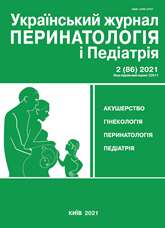Features of pathogenesis of itch and anti0itch therapy in children with allergic dermatosis (literature review)
DOI:
https://doi.org/10.15574/PP.2021.86.57Keywords:
children, allergy, allergic dermatoses, itch, anti-itch therapyAbstract
Allergic dermatoses are allergic skin diseases, the most common of which are: simple and allergic contact dermatitis, atopic dermatitis, various forms of eczema, acute and chronic allergic urticaria, Quincke's edema, toxicodermias, multiforme exudative erythema (Stevens–Johnson syndrome), acute epidermal necrolysis (Lyell's syndrome). The clinical course of all allergic dermatoses is accompanied by itch, although its severity varies depending on the nosology. An important focus of treatment of allergic dermatoses is to control of skin itch, as it is the leading symptom. According to the international program documents EAACI (European Academy of Allergy and Clinical Immunology), AAAAI (American Academy of Allergy, Asthma & Immunology), PRACТALL (Practical Allergology Consensus Report) in treatment of allergic dermatoses the leading place takes anti-itch therapy, which requires an individual approach and daily care of skin. Systemic anti-itch therapy includes using of the following drugs: antihistamines, glucocorticosteroids, membrane's stabilizators (kromons), leukotriene receptor antagonists, anti-IgE. External anti-itch therapy consists of local application of emollients, topical glucocorticosteroids, topical calcineurin inhibitors, topical anti-histamines, reparants and epithelializing medications.
Purpose — to increase knowledge about features of etiopathogenetically-based anti-itch therapy of allergic dermatoses in children.
Conclusions. Treatment of itch of allergic dermatoses is diverse, complex and multi-stage, requires an individual approach to each patient, and includes: environmental control to eliminate allergenic and non-allergenic factors, systemic and local pharmacotherapy, skin care. Modern anti-itch therapy of allergic dermatoses should be etiopathogenetic and affect on local and system mechanisms of allergic inflammation with itch, it should be differentiated according to the stage of the disease, the phase of inflammation and the severity of skin manifestations and to be based on the rational use of drugs.
No conflict of interest was declared by the author.
References
Beltrani VS. (1998). Allergic Dermatoses. Medical Clinics of North America. 82 (5): 1105-1133. URL: http://www.sciencedirect.com/science/article/pii/S0025712505704053. https://doi.org/10.1016/S0025-7125(05)70405-3
Dowling PJ, Kader R, Portnoy JM. (2019). COLA (Conferences On-Line Allergy) at 10 Years - Evolution of an Online Fellowship Curriculum. The Journal of Allergy and Clinical Immunology: In Practice. 7 (8): 2568-2573. URL: http://www.sciencedirect.com/science/article/pii/S2213219819305975. https://doi.org/10.1016/j.jaip.2019.06.025; PMid:31279862
Erickson S, Heul AV, Kim BS. (2021). New and emerging treatments for inflammatory itch. Annals of Allergy, Asthma & Immunology. 126 (1):13-20. URL: http://www.sciencedirect.com/science/article/pii/S1081120620303914. https://doi.org/10.1016/j.anai.2020.05.028; PMid:32497711
Fowler E, Yosipovitch G. (2019). Chronic itch management: therapies beyond those targeting the immune system. Annals of Allergy, Asthma & Immunology. 123 (2): 158-165. URL: http://www.sciencedirect.com/science/article/pii/S1081120619300857. https://doi.org/10.1016/j.anai.2019.01.016; PMid:30685562
Golpanian RS, Gonzalez JM, Yosipovitch G. (2020). Practical Approach for the Diagnosis and Treatment of Chronic Pruritus. The Journal for Nurse Practitioners. 16 (8): 590-596. URL: http://www.sciencedirect.com/science/article/pii/S1555415520302531. https://doi.org/10.1016/j.nurpra.2020.05.002
Katayama I, Izuhara K. (2017). Itch: Its perception and involvement in allergy. Allergology International. 66 (1): 1-2. URL: http://www.sciencedirect.com/science/article/pii/S132389301630168X. https://doi.org/10.1016/j.alit.2016.11.004; PMid:28081841
Lee C-H. (2016). Immune regulation in pathophysiology and targeted therapy for itch in atopic dermatitis. Dermatologica Sinica. 34 (1): 1-5. URL: http://www.sciencedirect.com/science/article/pii/S1027811715001123. https://doi.org/10.1016/j.dsi.2015.10.002
Leung DY. (2019). Cutaneous allergy: control that itch-scratch cycle. Annals of Allergy, Asthma & Immunology. 123 (2): 115. URL: http://www.sciencedirect.com/science/article/pii/S1081120619303928. https://doi.org/10.1016/j.anai.2019.05.016; PMid:31376840
Nguyen V, Simon L, Jaqua E. (2016). Allergic Dermatoses. Primary Care: Clinics in Office Practice. 43 (3): 433-449. URL: http://www.sciencedirect.com/science/article/pii/S0095454316300239. https://doi.org/10.1016/j.pop.2016.04.011; PMid:27545733
Rees J. (2005). Itch: basic mechanisms and therapy. Journal of the American Academy of Dermatology. 52 (3): 543-544. URL: http://www.sciencedirect.com/science/article/pii/S019096220403745. https://doi.org/10.1016/j.jaad.2004.09.045
Yang TL, Kim BS. (2019). Pruritus in allergy and immunology. Journal of Allergy and Clinical Immunology. 144 (2): 353-360. URL: http://www.sciencedirect.com/science/article/pii/S0091674919308280. https://doi.org/10.1016/j.jaci.2019.06.016; PMid:31395149 PMCid:PMC6690370
Yosipovitch G, Rosen Jordan Danie, Hashimoto T. (2018). Itch: From mechanism to (novel) therapeutic approaches. Journal of Allergy and Clinical Immunology. 142 (5): 1375-1390. URL: http://www.sciencedirect.com/science/article/pii/S0091674918313526. https://doi.org/10.1016/j.jaci.2018.09.005; PMid:30409247
Downloads
Published
Issue
Section
License
The policy of the Journal “Ukrainian Journal of Perinatology and Pediatrics” is compatible with the vast majority of funders' of open access and self-archiving policies. The journal provides immediate open access route being convinced that everyone – not only scientists - can benefit from research results, and publishes articles exclusively under open access distribution, with a Creative Commons Attribution-Noncommercial 4.0 international license(СС BY-NC).
Authors transfer the copyright to the Journal “MODERN PEDIATRICS. UKRAINE” when the manuscript is accepted for publication. Authors declare that this manuscript has not been published nor is under simultaneous consideration for publication elsewhere. After publication, the articles become freely available on-line to the public.
Readers have the right to use, distribute, and reproduce articles in any medium, provided the articles and the journal are properly cited.
The use of published materials for commercial purposes is strongly prohibited.

